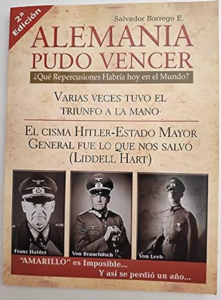Semantic juggling to get 900,000 prisoners killed
Eisenhower was supreme commander for political reasons. He seems to have been left with the temptation to win a battle himself, even if it was after the war was over and against unarmed prisoners.
Dwight David Eisenhower, commander of the Allied armies, was more a politician than a general. President Roosevelt promoted him from lieutenant colonel to major general in short order, without regard to service or rank. Eisenhower was the grandson of Jacob and Rebecca, a Jewish family that emigrated from Germany to the United States in the 18th century.
Both General Patton (American) and General Montgomery (British) were more competent than Eisenhower and performed more professionally from the Normandy invasion until the Allied victory in Germany. Perhaps that is why Eisenhower wanted to fight a ‘battle’ that he conceived and conducted himself. And so, at the end of the war, he agreed that one million German prisoners would not be treated as prisoners but as ‘unarmed enemies’, a classification invented by him to violate the Geneva and Hague Treaties regarding prisoners.
The one million German prisoners were not interned in concentration camps, nor in the many already empty barracks, but in eighty barbed-wire camps, completely in the open, with no sanitary facilities, no kitchens or canteens.
When it rained, the camps turned into quagmires. Scarce food was thrown at them as if they were dogs. Deaths were increasing due to pneumonia, pleurisy, gangrene, typhus, dysentery, etc. The International Red Cross wanted to bring them 100,000 tons of food, but Eisenhower forbade it, claiming that the Red Cross had no jurisdiction over ‘unarmed enemies’.
The 80 camps were scattered in Holland, Belgium, France and Germany. Some lacked water and prisoners drank their urine. Some cut branches from trees or dug holes in the ground for shelter, but this too was forbidden, and several bulldozers crushed the caves. Every day, several trucks hauled out scores of corpses. Some prisoners were so weakened that they fell into the improvised latrine pits and drowned.
Doctors James Mason and Charles Beasly of the US Medical Corps visited several of these camps, and in 1950 wrote: ‘Huddled together for warmth, behind barbed wire, was the most dreadful scene. Nearly a hundred thousand men, haggard, indifferent, dirty, haggard, staring into the void, their uniforms caked with mud, ankle-deep in the mud… These men had not eaten for days and the scarcity of water was their greatest problem, although only 180 metres away was the Rhine river running full to the banks.’
The Red Cross at least wanted to re-establish mail service, but Eisenhower refused. The US State Department disavowed Switzerland as a protective power for the POWs, in support of Eisenhower. Canada’s Prime Minister, Mackenzie King, then protested Washington’s agreement and was given no response. Instead, Eisenhower barred neutral observers from his eighty barbed wire camps.
General Montgomery, an Englishman, did not treat his prisoners as ‘unarmed enemy’, but as soon as they came under the jurisdiction of Eisenhower (who was the supreme commander), they were interned in the ‘enemy’ camps. According to partial reports, seventy thousand prisoners had died within two months, and the death toll was rising. Among the victims were even some women and children who did not want to be separated from their husbands or fathers, and they received the same discriminatory treatment.
A group of doctors from the US Medical Corps visited several camps and their report was on file at the National Archives in Washington. In one paragraph they said: ‘The most important killers were diarrhoea, dysentery, heart disease and pneumonia. Also starvation and exhaustion. The death rate was eighty times the normal average. Exposure to the elements, overcrowding in wells, and shortages of food and sanitary facilities all contributed to the excessive death rates.’
In July 1945, the French army took control of the camps in their area. Captain Julién took charge of Camp No. 11 and reported: ‘Muddy camp, populated by living skeletons, some of whom died on sight. Others huddled under pieces of cardboard to which they clung, even though the July days were hot. Women lay in holes in the ground with the oedema of hunger bulging their bellies in a gross parody of pregnancy. Long-haired old men looked on feebly. Children six or seven years old with black circles under their eyes from starvation stared with dull eyes’. Captain Julién immediately released 32,640 captives.
Eisenhower left command after seven months of forming his ‘unarmed enemy’ camps (November 1945). According to statistics, nine hundred thousand captives died. This was the greatest battle won by General Eisenhower, in which he did not need to fire a shot. Hailed by the international press and hailed as a hero in the United States, he was elected President for two terms, from 1953 to 1961.
Alfred M. de Zayas, an American jurist, says: ‘What can never be understood is how a nation like the United States, where not a single bomb fell, where not a single village was damaged, and which had no civilian casualties in the conflict, could instead devise a plan to exterminate the German population, as called for by U.S. Treasury Secretary Henry Morgenthau as early as February 12, 1933, in the Portland Journal, when there was not even talk of war, six years before the war began’.
There was, even before the war, an anti-German atmosphere, formed by international news agencies, books and violent statements from intellectual circles. Morgenthau (US Secretary of the Treasury) went so far as to call for depriving Germany of its industries to turn it into a country of shepherds. One year before the end of the war, a close friend of his, Theodor Kaufman (also a Jew), published the book Germany Must Perish!, in which he advocated the extermination of Germans by mass sterilisation.
